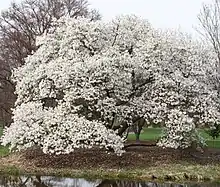| Magnolia kobus | |
|---|---|
 | |
| Magnolia kobus var. borealis[1] | |
| Scientific classification | |
| Kingdom: | Plantae |
| Clade: | Tracheophytes |
| Clade: | Angiosperms |
| Clade: | Magnoliids |
| Order: | Magnoliales |
| Family: | Magnoliaceae |
| Genus: | Magnolia |
| Subgenus: | Magnolia subg. Yulania |
| Section: | Magnolia sect. Yulania |
| Subsection: | Magnolia subsect. Yulania |
| Species: | M. kobus |
| Binomial name | |
| Magnolia kobus DC. | |
Magnolia kobus, known as mokryeon,[3] kobus magnolia,[3] or kobushi magnolia,[2] is a species of Magnolia native to Japan (Kyushu, Honshu, and Hokkaido) and Korea[4] and occasionally cultivated in temperate areas.[5] It is a deciduous, small to tall tree which has a slow rate of growth but can reach 8–15 m (25–50 ft) in height and up to 10 m (35 ft) in spread.
Classification
Two varieties of Magnolia kobus are recognized by some sources, such as Hortus Third,[5] with var. borealis being a tree to 25 m (75 ft) high, with leaves to 15 cm (6 in) long, and var. kobus, a tree to 10 m (30 ft) high, with leaves to 10 cm (4 in) long.
Magnolia kobus is classified within Magnolia subgenus Yulania.
The kobus magnolia is closely related to the star magnolia (Magnolia stellata), and some authorities consider the star magnolia to be a variety of M. kobus, M. kobus var. stellata.
Description
Magnolia kobus blooms in the early spring, bearing pleasantly fragrant white flowers with hints of pale pink about 10 cm (4 in) in diameter. The flowers are produced before the leaves, as with most members of Magnolia subgenus Yulania. Young trees do not flower.
The summer foliage of the kobus magnolia is dark green. Leaves have an obovate shape with a pointed tip, a smooth, or glabrous, leaf underside, and smooth, even edges. Leaves are 8–15 cm (3–6 in) long, in an alternating arrangement. In autumn, the leaves take on a yellow color and drop from the tree.

The fruit of the kobus magnolia grows in groups of small red seeds. The groupings are one to three inches in size, and the seeds attract birds.
Older bark, such as that of the trunk, is grey-brown, while new stems are green with small brown spots. There is a strong odor to broken branches or twigs.
Several news outlets reported that in November 1982,[6] seeds estimated to be 2,000 years old was found by a Hiroshi Utsunomiya of Yamaguchi University in a pit in the ancient Bronze Age village of Asada. He planted a number of seeds, assuming that they would not grow. However, this assumption was proven incorrect. Interestingly, the flowers of the grown plant had 7 or 8 petals on its blossoms rather than the six petals typical of a kobus magnolia.[7]
Gallery
 Jaekseol tea blended with magnolia petals
Jaekseol tea blended with magnolia petals seeds
seeds Autumn buds
Autumn buds flowers
flowers leaves
leaves
References
- ↑ Cirrus Digital: Northern Japanese Magnolia Magnolia kobus
- 1 2 "The IUCN Red List of Threatened Species". IUCN Red List of Threatened Species. Retrieved 27 June 2019.
- 1 2 English Names for Korean Native Plants (PDF). Pocheon: Korea National Arboretum. 2015. p. 552. ISBN 978-89-97450-98-5. Archived from the original (PDF) on 25 May 2017. Retrieved 20 January 2017 – via Korea Forest Service.
- ↑ "Magnolia kobus". Germplasm Resources Information Network. Agricultural Research Service, United States Department of Agriculture.
- 1 2 Bailey, Liberty Hyde & Ethel Zoe Bailey (1976). Hortus Third: A Concise Dictionary of the Plants Cultivated in the United States and Canada. Revised and expanded by the staff of the Liberty Hyde Bailey Hortorium. New York: MacMillan (and Collier MacMillan, London). pp. xiv + 1290. ISBN 9780025054707.
- ↑ "Scientist Grows Magnolia from Seed Found in 2,000-Year-Old Tomb". Associated Press.
- ↑ "BBC Two - The Private Life of Plants". BBC. 45 minutes. Retrieved 27 June 2019.
